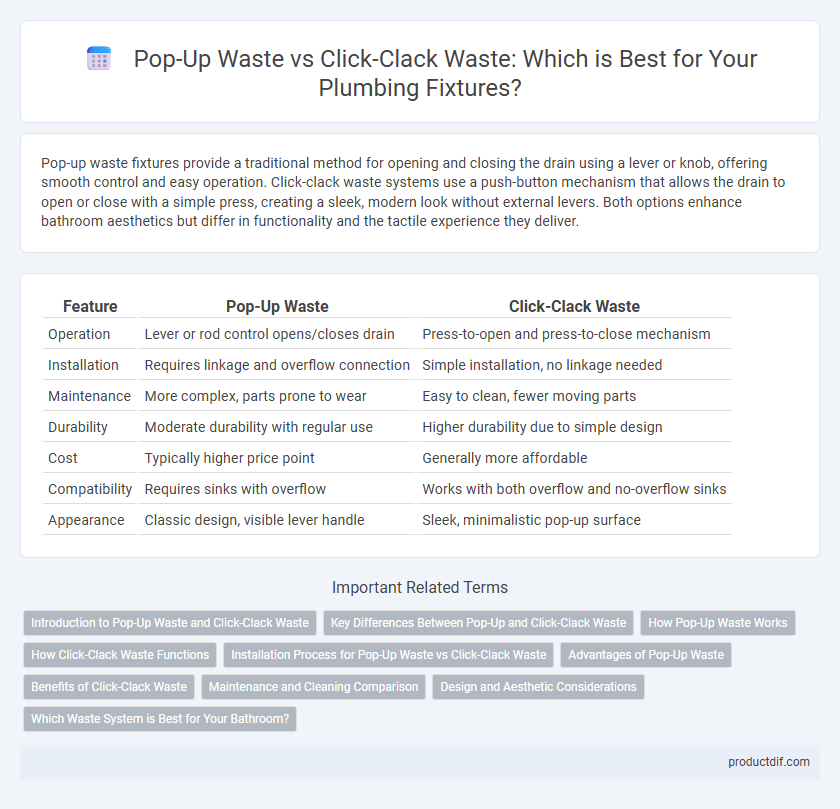Pop-up waste fixtures provide a traditional method for opening and closing the drain using a lever or knob, offering smooth control and easy operation. Click-clack waste systems use a push-button mechanism that allows the drain to open or close with a simple press, creating a sleek, modern look without external levers. Both options enhance bathroom aesthetics but differ in functionality and the tactile experience they deliver.
Table of Comparison
| Feature | Pop-Up Waste | Click-Clack Waste |
|---|---|---|
| Operation | Lever or rod control opens/closes drain | Press-to-open and press-to-close mechanism |
| Installation | Requires linkage and overflow connection | Simple installation, no linkage needed |
| Maintenance | More complex, parts prone to wear | Easy to clean, fewer moving parts |
| Durability | Moderate durability with regular use | Higher durability due to simple design |
| Cost | Typically higher price point | Generally more affordable |
| Compatibility | Requires sinks with overflow | Works with both overflow and no-overflow sinks |
| Appearance | Classic design, visible lever handle | Sleek, minimalistic pop-up surface |
Introduction to Pop-Up Waste and Click-Clack Waste
Pop-up waste and click-clack waste are two popular types of plumbing fixtures used in sinks and basins for efficient water drainage. Pop-up waste features a lever mechanism that allows users to open or close the drain by pushing or pulling a rod, offering smooth operation and easy maintenance. Click-clack waste operates with a simple push mechanism that clicks to open or close the drain, providing a modern, user-friendly design with minimal effort.
Key Differences Between Pop-Up and Click-Clack Waste
Pop-up waste features a lever-operated mechanism that lifts and seals the drain stopper, allowing precise control over water retention in sinks or baths. Click-clack waste operates with a simple press action, where pushing the stopper once closes the drain and pressing again opens it, offering a more streamlined and user-friendly experience. Key differences include installation complexity, where pop-up wastes often require linkage and more space, while click-clack wastes fit directly into the drain hole, making them easier to install and maintain.
How Pop-Up Waste Works
Pop-up waste operates using a lever mechanism connected to the sink's faucet or a separate knob that lifts or seals the drain stopper internally, allowing water to either drain or be retained. The system relies on a horizontal lift rod or vertical plunger, which engages with a pivot rod linked to the drain stopper, creating a smooth opening and closing movement. This mechanism ensures convenient one-handed operation and effective water retention without manual removal of the stopper.
How Click-Clack Waste Functions
Click-clack waste operates by pressing the drain cover to open or close the water flow, utilizing a spring-loaded mechanism that clicks into place. This design allows for easy operation without the need for a separate lever or rod, streamlining the aesthetics of bathroom sinks. Its simple push-to-toggle function provides reliable water drainage control compared to traditional pop-up waste systems.
Installation Process for Pop-Up Waste vs Click-Clack Waste
The installation process for pop-up waste typically involves connecting a horizontal rod to the drain mechanism, which requires precise alignment and adjustment to ensure smooth operation. Click-clack waste installation is more straightforward, as it features a push-button mechanism that fits directly into the sink hole with a simple twist-and-lock system, eliminating the need for external rods or levers. Pop-up waste systems often require more time and technical skill, while click-clack wastes offer quicker, tool-free setup ideal for DIY projects.
Advantages of Pop-Up Waste
Pop-up waste systems provide precise control over water drainage, allowing users to easily seal or release the sink without splashing. Their streamlined operation ensures a better waterproof seal, reducing the risk of leaks compared to click-clack waste systems. Pop-up wastes are also known for their durability and are less prone to mechanical failure due to fewer moving parts exposed to water.
Benefits of Click-Clack Waste
Click-clack waste offers superior ease of use with a simple press mechanism that opens and closes the drain efficiently, reducing the risk of water leakage compared to traditional pop-up waste systems. Its sleek, modern design enhances bathroom aesthetics while requiring less maintenance due to fewer moving parts prone to failure. Installation is typically straightforward, providing a reliable and user-friendly solution for contemporary plumbing fixtures.
Maintenance and Cleaning Comparison
Pop-up waste systems feature a lever mechanism that can be prone to clogging and require regular cleaning to prevent buildup around the pivot rod and seal. Click-clack waste offers a simpler design with a push-button operation that minimizes internal moving parts, reducing maintenance needs and easing access for cleaning. Both systems benefit from periodic removal and inspection, but click-clack waste generally provides a more streamlined and user-friendly cleaning process.
Design and Aesthetic Considerations
Pop-up waste features a discreet lever or knob operated from the sink, offering a streamlined and minimalist look that complements modern bathroom designs. Click-clack waste uses a push-button mechanism with a chrome or brushed metal finish, providing a sleek surface that enhances contemporary vanity aesthetics. Both options integrate seamlessly into various basin styles, but click-clack wastes typically create a cleaner, more uniform appearance due to their flush-fitting design.
Which Waste System is Best for Your Bathroom?
Choosing the best waste system for your bathroom depends on functionality and design preferences; pop-up wastes offer a classic lever mechanism allowing easy operation for sinks and bathtubs, ideal for seamless water release. Click-clack wastes feature a push-to-open and close button, providing a modern, minimalist look and are typically easier to install and clean, making them suitable for contemporary bathrooms. Both systems ensure efficient drainage but selecting between pop-up and click-clack waste hinges on user convenience and aesthetic compatibility with your bathroom fixtures.
pop-up waste vs click-clack waste Infographic

 productdif.com
productdif.com